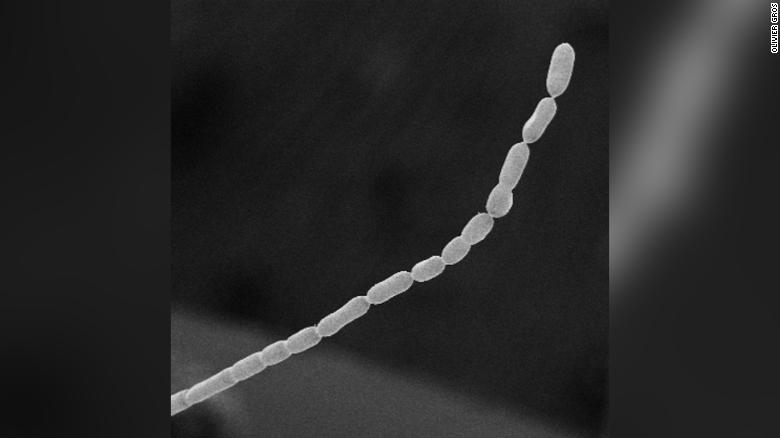They found new hyperresistant bacteria in Antarctica 0:37
(CNN) --
This is a bacterium like never seen before, probably because, until now, all known bacteria could only be seen through a powerful light microscope.
A newly discovered bacterium that is large enough to see with the naked eye, and resembles the shape and size of an eyelash, has been found in Guadeloupe in the Lesser Antilles, according to a study published Thursday in the journal Science.
Thiomargarita magnifica
, in reference to its exceptional size, has an average cell length of over 9,000 micrometers, which is equivalent to almost a centimeter in length.
The cells of most bacterial species are about 2 micrometers long, although the largest can reach 750 micrometers.
T. magnifica
can grow up to 2 centimeters long, according to study co-author Jean-Marie Volland, a marine biologist and scientist at the California Complex Systems Research Laboratory, and affiliated with the US Department of Energy's Joint Genome Institute. USA
"To understand how gigantic this is for a bacterium, it's like finding a human as tall as Mount Everest," he told CNN on Wednesday.
T. magnifica
bacteria
can grow up to 2 centimeters, according to a new study.
More than 625,000
E. coli
bacteria could fit on the surface of a single
T. magnifica
.
Despite its size, however, the bacterium has a "remarkably pristine" surface, devoid of bacteria that live on the surface of living plants and animals, according to the study.
advertising
These incredible plants are a water factory for millions of people in Colombia, but they could soon disappear
How does it maintain its size?
It was previously thought that bacteria could not grow to a size visible to the naked eye because of the way they interact with their environment and produce energy.
But the T. magnifica
bacterium
has an extensive network of membranes that can produce energy, so it doesn't just rely on its surface to absorb nutrients through its cell.
Volland was able to view the huge cells in 3D using shortwave X-ray tomography, confocal microscopes and transmission electron microscopy, according to a press release.
A
T. magnifica
cell has its DNA contained in small membrane-bound organelles.
Unlike most bacteria, which have their genetic material floating freely inside their single cell, a
T. magnifica
cell has its DNA contained in small membrane-bound sacs called pepins.
"This is a very interesting discovery that raises many questions because it is not something that is classically observed in bacteria. In fact, it is a characteristic of more complex cells, of the type of cells that make up our body or animals and plants" Volland explained.
"We want to understand what these pepins are and what exactly they do, and whether they play a role in the evolution of gigantism in these bacteria, for example."
T. magnifica
was discovered in Guadeloupe.
According to the study,
T. magnifica
was first discovered growing as fine white filaments on the surface of decaying mangrove leaves in shallow tropical marine mangroves in Guadeloupe.
These giant bacteria grow in the bottom sediments of sulfurous waters, where they harness the chemical energy of sulfur and use oxygen from the surrounding water to make sugars, according to Volland.
T. magnifica
can also make food from carbon dioxide.
Chilean researchers found hyperresistant bacteria in Antarctica.
Can they pose a health risk?
It has been suggested that, being much larger than the average bacterium, a
T. magnifica
cell might be better able to access oxygen and sulfur from its environment at the same time, according to Volland.
It's also possible that the large size of
T. magnifica
cells compared to other members of the bacterial population means they don't have to worry about being eaten by predators.
Underwater view of one of the Guadalupe mangroves that the researchers sampled between April and May 2022.
It is necessary to conserve more than 40% of the earth's surface to stop the biodiversity crisis, warns report
A microbial "black box"
Tanja Woyke, a senior scientist at California's Lawrence Berkeley National Laboratory, thinks it's likely the giant bacteria, or related species, could be found in other mangroves around the world.
"It always strikes me how little we know about the microbial world and how much is out there," he told CNN on Wednesday, adding that the microbial world "remains a black box."
Woyke, who directs the Microbial Genomics Program at the US Joint Energy Institute, is one of the lead authors of the study.
"Confirmation bias related to the size of viruses prevented the discovery of giant viruses for more than a century," the study concludes.
"The discovery of Ca. T. magnifica suggests that larger, more complex bacteria may be hiding in plain sight."
"Just because we haven't seen it yet doesn't mean it doesn't exist," Woyke added.
BacteriaDiscoveries

